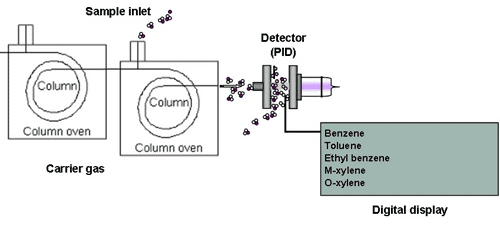Introduction to Gas Chromatographs
There are many detectors which can be used in Gas Chromatography, different detectors will give different types of selectivity. A non-selective detector responds to all compounds except the carrier gas, a selective detector responds to a range of compounds with a common physical or chemical characteristic, and a specific detector responds to a single chemical compound. All of the portable Gas Chromatographs in EQUIPCO's rental pool are either the Selective Detector type or the Specific Detector type. Gas chromatographs are used in a wide variety of applications such as:
- Hazardous waste sites
- Clean-up of spills
- Protecting workers from toxic vapors
- Refineries
- Leak detection for compliance
- Pulp and paper plants
- Hazardous materials response
- Terrorist chemical attacks
How Does a Gas Chromatograph Work?
Gas Chromatography involves a sample being vaporized and either sample-drawn (via an internal pump) or injected onto the head of the GC column. The sample is transported through the column by the flow of an inert gas such as carbon dioxide or nitrogen. The column is generally packed with a finely divided, inert, solid support material coated with liquid stationary phase. The sample compounds adhere to the inside walls of the columm and as the column is heated the compounds are released and transported to the detection chamber (PID type detector in all EQUIPCO GCs) where the molecules are ionized, causing them to release an electron and form a positive ion. Ions in the sample are driven in one direction by a bias electrode and accumulated at a collecting electrode. The ion current is then amplified and converted to a digital meter readout in parts-per-billion (ppb) or parts-per-million (ppm). The GC is able to identify the specific compound based on the amount of time that elapsed once the sample was taken and the heat cycle began, to the detector responding to a compound.
Gas Chromatograph (GC)

